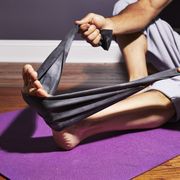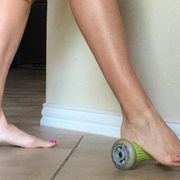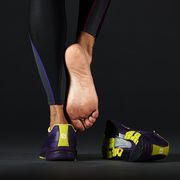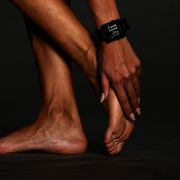Runners generally don’t appreciate their plantar fascia until it becomes a problem. But when the plantar fascia does become a problem, it’s (unfortunately) one that’s going to haunt you for miles and miles.
If you’ve been diagnosed with partial plantar tear or suspect you have one, you probably won’t need surgery, but you’ll definitely be sidelined longer than you’d like. Here’s the deal.
What is Plantar Fascia?
So, uh, what is it? “The plantar fascia is a tough band of connective tissue that spans the longitudinal axis of the foot between the heel bone (calcaneus) and the base of the proximal phalanges,” explains William O. Roberts, M.D., professor of family medicine at the University of Minnesota. “The tissue forms the tension portion of the tension-compression structure that makes up the longitudinal arch, and it resists the pressure on the arch to fall flat. It also acts as a “windlass” to tighten the longitudinal foot to toe when walking and running.” In other words, it keeps your feet functioning properly.
More From Runner's World

So obviously, your plantar fascia is crucial to running. “Each time you take a step during a run, your foot pronates to absorb the shock, applying a flattening force to the arch of the foot, thus placing tension on the plantar fascia,” explains Sophia Solomon, D.P.M., a sports medicine podiatrist with Manhattan Foot Specialists. “This tension leads to anything from inflammation (plantar fasciitis) to a partial fascial tear and even a full rupture of the plantar fascia.”
Plantar Fasciitis vs. Partial Plantar Tear
When you experience micro tears in the plantar fascia, that’s called plantar fasciitis. It’s one of the most common running injuries, and will affect one in 10 people during their lifetimes. “Plantar fasciitis is inflammation of the plantar fascia that can result in pain or swelling,” explains Damian Roussel, a podiatrist with The Centers for Advanced Orthopaedics. It’s an accumulative issue, one that results from too much tension or stress on the plantar fascia.
On the other hand, “a partial plantar fascia tear involves an actual rip in the fascia,” says Roussel. It’s a relatively uncommon injury, and it’s usually caused by one specific incident, “such as when a runner takes a step that generates a forceful push into the middle of the foot,” says Roussel. “They’ll likely feel a rip or pull on the bottom of the foot, and the runner will immediately know that something is wrong.”
What Are the Symptoms?
The main difference between plantar fasciitis and a plantar tear: The tear is going to hurt a hell of a lot more in the moment.
“The general presentation of a partial plantar fascia tear is an episode of intense foot loading (a jump or sprint) resulting in a tearing sensation in the foot and subsequent heel or arch pain,” says Solomon.
Other symptoms include: intense pain in the heel or arch while walking or at rest, a painful lump in the arch of the foot or heel with swelling or bruising, hearing or feeling a pop or tearing in the foot, the collapsing of the arch, pain when toes are bent upward, and difficulty walking, adds Victor Nwosu, D.P.M., a foot and ankle surgeon at The CORE Institute at Porretta Center for Orthopedic Research and Education.
How Do You Treat It?
Here’s the good news: “A plantar fascia partial tear is not generally considered a surgically repairable injury because it usually heals well on its own and the surgical access might have more risk of scarring than the potential for improvement,” says Roberts
The bads new: Healing the tissue back to full strength takes 12 or more weeks. “The usual treatment is to control the pain, put the arch and foot at rest to allow the tissue to reconstruct, and as the symptoms begin to settle over a week or two, begin gentle stretching and limited, protected walking,” Roberts says. “Normal standing or walking may be possible in a few weeks. The return to high-level running may require several months.”
Doctors will typically put patients with a partial plantar tear in a removable cast or boot to immobilize the foot for three to four weeks. “During that time, we generally recommend ice, taking an oral anti-inflammatory, and physical therapy,” Roussel adds. “When we remove the boot and get the patient back into sneakers, we’ll recommend typical plantar fasciitis treatments until they can get back to regular activity: more anti-inflammatories, more PT, home stretching, ice, rest, and supportive shoes with arch support or orthotics.”
How to Prevent It
If you’re not looking to get sidelined for three months or more (and really, who is?), the best thing you can do is prevent plantar fasciitis and partial plantar tears before they strike. “Preventative efforts should focus on understanding and addressing the underlying cause: tight calf muscles and faulty mechanics,” says Nwosu.
Calf tightness is a major contributing factor in most foot and ankle problems. Consistent stretching and rolling of the calf and plantar fascia can go a long way in preventing micro (or worse, full) tears. “I recommend variations of ‘toes to nose’ stretches, which involve keeping the knee straight and pulling the toes towards the body,” says Roussel.
If you’re already experiencing some issues, a more supportive shoe or foot orthotic or insert could stave off anything more serious. “You can decrease your likelihood of a tear by wearing a supportive shoe with a semi-rigid insole of a medium-height arch,” says Solomon. “The insole should be hard enough that you cannot twist the arch or heel of the insole more than 25 degrees in any direction.”
[Stay injury free on the road by getting on the mat with Yoga for Runners.]
A few minutes of stretching and foam rolling, and maybe shelling out for more supportive shoes versus three months sidelined from running? This shouldn’t be too tough of a decision.













